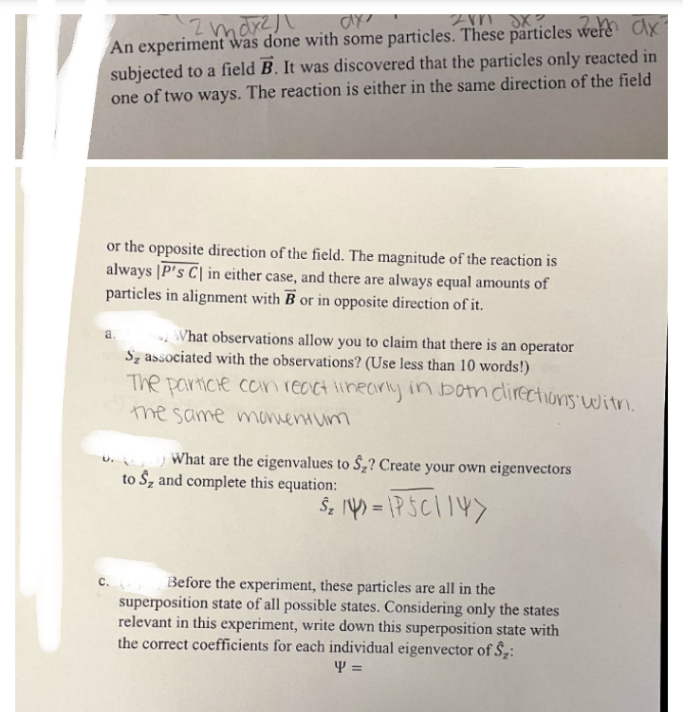e opposite direction of the field. The magnitude of the reaction ys [P's C| in either case, and there are always equal amounts « cles in alignment with B or in opposite direction of it
e opposite direction of the field. The magnitude of the reaction ys [P's C| in either case, and there are always equal amounts « cles in alignment with B or in opposite direction of it
Elements Of Electromagnetics
7th Edition
ISBN:9780190698614
Author:Sadiku, Matthew N. O.
Publisher:Sadiku, Matthew N. O.
ChapterMA: Math Assessment
Section: Chapter Questions
Problem 1.1MA
Related questions
Question

Transcribed Image Text:are
An experiment was done with some particles. These particles were Cx
subjected to a field B. It was discovered that the particles only reacted in
one of two ways. The reaction is either in the same direction of the field
or the opposite direction of the field. The magnitude of the reaction is
always [P's C| in either case, and there are always equal amounts of
particles in alignment with B or in opposite direction of it.
What observations allow you to claim that there is an operator
Sz associated with the observations? (Use less than 10 words!)
The particle can react linearly in botniclirectionns Witn.
the same monient um
a.
What are the eigenvalues to Ŝ;? Create your own eigenvectors
to Ŝz and complete this equation:
U.
$. IY) = \P SC| 14>
c.
Before the experiment, these particles are all in the
superposition state of all possible states. Considering only the states
relevant in this experiment, write down this superposition state with
the correct coefficients for each individual eigenvector of Ŝ;:
Expert Solution
This question has been solved!
Explore an expertly crafted, step-by-step solution for a thorough understanding of key concepts.
Step by step
Solved in 2 steps

Knowledge Booster
Learn more about
Need a deep-dive on the concept behind this application? Look no further. Learn more about this topic, mechanical-engineering and related others by exploring similar questions and additional content below.Recommended textbooks for you

Elements Of Electromagnetics
Mechanical Engineering
ISBN:
9780190698614
Author:
Sadiku, Matthew N. O.
Publisher:
Oxford University Press

Mechanics of Materials (10th Edition)
Mechanical Engineering
ISBN:
9780134319650
Author:
Russell C. Hibbeler
Publisher:
PEARSON

Thermodynamics: An Engineering Approach
Mechanical Engineering
ISBN:
9781259822674
Author:
Yunus A. Cengel Dr., Michael A. Boles
Publisher:
McGraw-Hill Education

Elements Of Electromagnetics
Mechanical Engineering
ISBN:
9780190698614
Author:
Sadiku, Matthew N. O.
Publisher:
Oxford University Press

Mechanics of Materials (10th Edition)
Mechanical Engineering
ISBN:
9780134319650
Author:
Russell C. Hibbeler
Publisher:
PEARSON

Thermodynamics: An Engineering Approach
Mechanical Engineering
ISBN:
9781259822674
Author:
Yunus A. Cengel Dr., Michael A. Boles
Publisher:
McGraw-Hill Education

Control Systems Engineering
Mechanical Engineering
ISBN:
9781118170519
Author:
Norman S. Nise
Publisher:
WILEY

Mechanics of Materials (MindTap Course List)
Mechanical Engineering
ISBN:
9781337093347
Author:
Barry J. Goodno, James M. Gere
Publisher:
Cengage Learning

Engineering Mechanics: Statics
Mechanical Engineering
ISBN:
9781118807330
Author:
James L. Meriam, L. G. Kraige, J. N. Bolton
Publisher:
WILEY